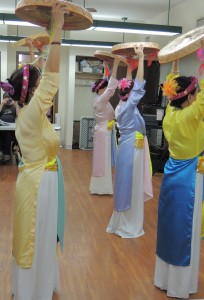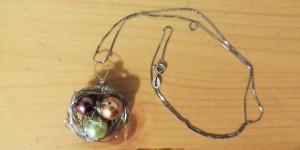
The LMNH Vietnamese Dancers treat the Volunteer Connections workshop to a performance at the end of a busy day – photo by Christine Park
At Little Mountain Neighbourhood House I have been working with a group called Volunteer Connections since the start of my placement. An ambitious, lively leadership group of mostly immigrant women, Volunteer Connections has most recently been making bird’s nest pendants out of wire for a fundraising project. Each meeting has a chock-full schedule: an open listening circle to start off, discussions of marketing and profit for necklace sales, making the necklaces, and often the meeting ends with some musical performances by the talented members of the group. Working with this incredibly vibrant and diverse group has been an excellent place to explore the concept of how community building occurs and creates a sense of unity between members of different cultures. At Volunteer Connections, this is done through art and creative expression.
The members of Volunteer Connections come from all over the world: China, Vietnam, Latin America, Europe and North America. With so many different cultural backgrounds working together, the main thing Volunteer Connections has done to become a cohesive group is to find some common ground. According to one of the program facilitators, Jennifer, this has been done through art: “It’s a different language… I mean, we all speak how many different languages? So many in this room! But the language of art is something we have in common… it’s something we can do together, and we don’t always have to speak words but we can just be with each other and create.” (Jennifer Wesman, personal communication) I’ve seen this principle in action when working with the Volunteer Connections group – some of the most tender and inspiring moments have been when members of the group have planned mini performances of art from their own cultures to share with the group. For example, when one member and her father performed a traditional Argentinean song, very few people in the room could understand the Spanish lyrics. But everyone was supportive, and the feelings of connection were clearly visible between the performers and the audience.
The social enterprise project, the bird’s nest pendants, is an artistic endeavour unto itself. What is most remarkable about this particular choice of jewellery design is that it also acts as a very apparent and frequently referenced metaphor for the purpose of the group. Frequently I hear the group discuss togetherness and how the Volunteer Connections group has been a place for them to be nurtured, much like a nest. One of the participants told me that without groups like Volunteer Connections she would feel isolated and lonely in Canada, because she wouldn’t have limited opportunities to connect with others. This sentiment recalls for me what Lauer and Yan point out in their article on Neighbourhood House programs: ““Involvement in associations… allows for the intermingling of people and the creation of ties that bridge social cleavages of class, gender, race, and ethnicity.” (2007: 12) Because of the open structure LMNH has provided with a workshop like Volunteer Connections, participants are able to connect with each other across language and cultural barriers and bond over the experience of creating art together.
Citations
Lauer, S.R. and Yan, M.C.
2007 Neighbourhood Houses and Social Ties. Centre of Excellence for research on Immigration and Diversity: Working Paper Series.
Wesman, Jennifer
2012 Personal Communication, at Little Mountain Neighbourhood House June 9

